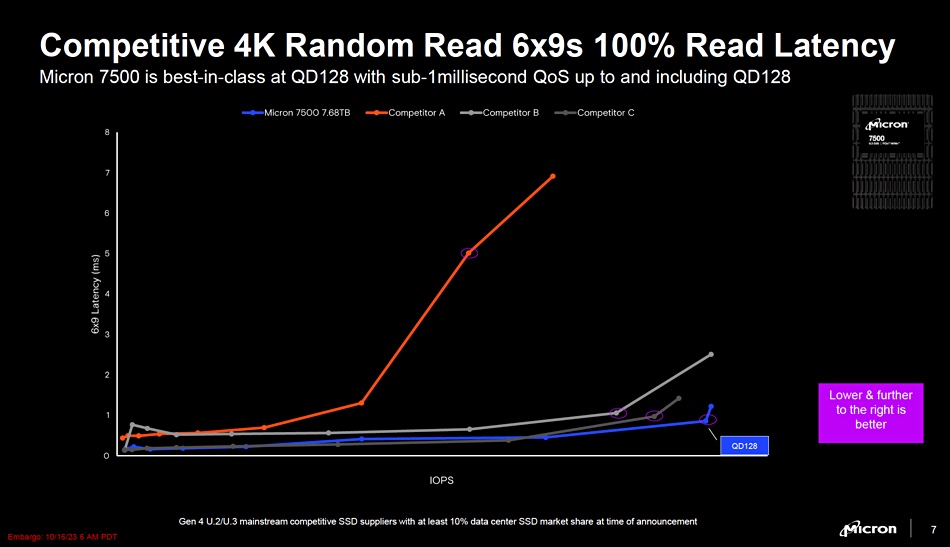Micron is launching a 7500 datacenter SSD using 232-layer 3D NAND technology, exceeding the prior 7450 drive on all counts except random write IOPS where both drives are equal.
The 176-layer 7450 with a PCI gen 4 interface was launched in March 2022 as a successor to the 7400 and its 96-layer 3D NAND. It came in U3, E1.S, and M.2 formats, whereas the 7500 is solely available in the U.3 format. Micron is focusing consistently on reliable low latencies with the 7450 delivering sub-2ms latency and the 7500 improving that.

Alvaro Toledo, VP and GM of Micron’s Data Center Storage group, said: “We have achieved a breakthrough in latency, enabling response times below 1ms for 6x9s QoS in mainstream drives. This means our customers can run their data-intensive workloads faster, more efficiently and with more predictability than ever before.”

Compared to the 7450, the 7500 has faster sequential read and write bandwidth and random read IOPS. Speeds in our table are “up to” speeds and vary with capacity.
The 7500 has broad support for the Open Compute Project (OCP) SSD 2.0 specification, which provides intelligent management, performance optimization, seamless integration, and error handling for datacenter environments.
Micron provided charts showing how the 7500’s performance compares with other suppliers’ drives in the same market category:

We understand the competing drives may be Solidigm’s DC P5430 (red line), an SK hynix SSD (light grey) and a Kioxia drive (dark grey). The chart shows the 7500 being equivalent to Kioxia’s drive but eventually beating it, while it is always faster than the SK hynix drive and much better than Solidigm’s SSD. That’s not surprising as Solidigm’s device uses QLC NAND, not TLC as all the others do.
A RocksDB competitive comparison shows the 7500 having better performance again:

The light grey and dark grey lines represent the same competitors as above.
Micron has equipped the 7500 with many security features:
- Administrative commands to allow standardized control over functions such as namespaces and security, which easily integrate with OCP-compliant management systems.
- Latency monitoring to improve performance by enabling the tracking and diagnosis of latency issues reported through the storage stack.
- Error recovery and error injection features to enable rapid recovery of the drive and simulation of errors commonly encountered in servers.
- Self-encrypting drive (SED) options with AES-256 hardware-based data encryption, running at line rate, SHA-512 and RSA to keep data safe.
- Secure Encrypted Environment (SEE) to provide dedicated security processing hardware with physical isolation for improved security.
- SPDM 1.2 attestation verifies device identity and firmware integrity to validate trust in the SSD from manufacturing through deployment.
- Options for FIPS 140-3 Level 2 and TAA compliance to meet U.S. federal government procurement requirements.
The 7500 is available now through Micron’s OEMs and channel partners. Check out a product brief here.







